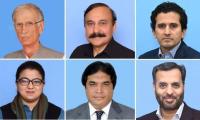The writer holds a PhD from the University of Birmingham, UK and works in Islamabad.
Many senior journalists, and observers of the media in Pakistan often complain about new or younger media professionals who have become self-styled promoters of chauvinism, jingoism and sectarian tendencies in the country. This point appears to have some truth in it.
We find an overwhelming majority of professionals in the media belonging to a mindset which peddles a narrow-minded and parochial approach to journalism. The values of quality journalism are declining and a self-righteous approach is evident among anchors, columnists, editors, and even in investigative reporters, if any are left. Some of the basic values of quality journalism should include a broadminded approach, focus on accuracy, and fairness. Ideally for good journalism, democratic and human rights should take precedence over all discrimination based on ethnicity, faith, gender or any other prejudices.
Sadly, in Pakistani media – be it electronic, print or social – minorities are neglected, or rather face an aggressive attitude from the majority. If there is some wrong done against non-Muslims, many newspapers and TV channels just suppress such news. Some Urdu magazines and newspapers even run hate campaigns against smaller religious groups. There are special editions and supplements that advertently or inadvertently promote sectarianism. Rather than challenging and questioning chauvinism and jingoism, such narratives are buttressed and promoted. To understand this phenomenon, in a series of articles we will have a look at some of the textbooks of journalism that students read at college and university levels in Pakistan.
This does not claim to be a comprehensive review of all textbooks of journalism in the country. In this series, we will also discuss some non-textbook material that our journalists and students of journalism may find useful to obtain a broader perspective of journalism and society at large. For journalists and students of journalism in Pakistan, there are plenty of textbooks but a majority of them are from foreign authors who focus more on mass communication in general, and not specifically on Pakistan or on developing countries.
A look at the curriculum that journalism students go through in public universities of Pakistan, shows a dismal picture in the sense that most of it is concentrated on technical aspects of journalism. There are courses on let’s say: journalistic language, reporting, sub-editing, media history, and communication theory. There are also modules on advertising, broadcasting, Pakistan affairs and public relations; but hardly anything on censorship (both covert and overt), constitutionalism, critical thinking, democracy, development issues such as education and health and their coverage, gender studies, human rights, knowledge development and management and minority problems.
Though some private universities have modified their curriculum to include some of the courses mentioned above, most public-sector universities lag far behind especially for Urdu medium students. In Pakistani colleges and universities, Urdu medium students read textbooks that are full of information about the evolution of journalism in the subcontinent. For example, Dr Abdus Salam Khurshid wrote dozens of books in Urdu. Especially his three books, ‘Dastan-e-Sahafat’ (the story of journalism), Fun-e-Sahafat (The art of journalism) and ‘Sahafat Pak-o-Hind Mein’ (Journalism in Pakistan and India) are a staple for students reading for their journalism degrees in Urdu medium.
His PhD thesis which this columnist has in his collection was titled ‘Newsletters in the Orient’ completed at the University of Amsterdam. Dr Khurshid taught journalism at the University of Punjab from 1950 to 1980, and his total number of books exceeds 100. He was a son of Abdul Majeed Salik who himself was a renowned journalist from pre-Partition days. Interestingly, both Khurshid and Salik were initially drawn towards the Progressive Writers Association (PWA). Dr Ghulam Shabbir of Islamia University of Bahawalpur writes in his paper on Bari Alig the following:
“In December 1947 some progressive writers held a conference in Lahore in which Sahir Ludhyanvi and Ahmed Rahi were also active. Syed Sajjad Zaheer inaugurated the conference that Maulana Abdul Majeed Salik presided over. According to Dr Abdus Salam Khurshid the conference formulated and approved the manifesto of the association… On January 29, 1948 in a gathering of writers the PWA elected its office bearers as follows: Secretary Abdus Salam Khurshid; Joint Secretary Abdullah Malik, Arif Abdul Mateen; Finance Secretary Abdul Majeed Bhatti; executive committee members Faiz Ahmed Faiz, Bari Alig, Sahir Ludhyanvi, M Akhtar, and Tufail Ahmed.” (Page 164; Journal of Research, Faculty of Languages and Islamic Studies; 2003, Vol 3)
But soon A S Khurshid, Bari Alig, Majeed Salik and many others left the PWA. Salik died in 1959 and his son Khurshid drifted towards the right-wing. Dr Khurshid in his 100 or so books hardly ever criticized any dictatorship in Pakistan; he even advocated and justified censorships imposed by them in the name of national security. For example, he presented a paper titled ‘Mass Communication Media in Pakistan’ at an international seminar in September 1971 when military action was at its peak in East Pakistan. In his nearly 30-page paper you will hardly find anything about censorship during the military dictatorships of Generals Ayub Khan and Yahya Khan.
There was a near-complete blackout of what was actually happening in East Pakistan, but Dr Khurshid was not bothered about it. While journalists such as Hussain Naqi, I A Rehman, Waris Mir, and some others were criticizing the military action, Dr A S Khurshid had nothing to say about it. For example just look at the following paragraph:
“The press in Pakistan has made very significant progress during the last ten years. This is the outcome of the emerging pattern of a new society which in turn is the logical result of the growing pace of urbanization, industrial expansion, rise in literacy, and increase in the educational facilities. To be precise, circulation of daily newspapers was not more than three per thousand inhabitants in 1958. Today despite a substantial increase in population, it is eight per thousand inhabitants. The figure if compared to those of advanced countries, seems to be very low but it does mark an appreciable rise.”
This he wrote in 1971 when Pakistan had endured 13 years of military dictatorships that had done everything possible to destroy democracy and human rights in Pakistan and had complete control of electronic and print media in the country. In 1971, General Yahya Khan had imposed a very strict ban on any objective reporting from East Pakistan when the Awami League which had won absolute majority from there was being brutally crushed and had been denied their democratic right to rule. But A S Khurshid was writing the following:
“A reassuring aspect is the rapid growth of the national language press. Of an estimated total circulation of eight hundred thousand, English-language newspapers account for about one hundred and fifty thousand copies. Only a decade back, no Urdu paper could even dream of attaining a circulation equal to that of the most widely circulated English daily. Today it is just the reverse. The largest circulated daily in Urdu has a circulation more than three times that of the largest-circulated among the English dailies. In East Pakistan too, the circulation of the most popular English daily is less than the circulation of the most popular Bengali daily.”
You see the entire article which is available on the internet is full of praise and recounts his own version of how journalism had progressed in Pakistan. In a couple of lines he touches censorship by saying that “all countries in the world have such regulations” – meaning there was nothing wrong about it. Most of his textbooks are concerned with the history of journalism or the technical aspects of editing and writing.
Another big name in journalism textbooks in Pakistan is Miskeen Ali Hijazi, again an author of dozens of textbooks in Urdu. He was head of department at Punjab University and taught there for 30 years till his retirement in 1997. We will discuss him in the next piece.
To be continued
Email: mnazir1964@yahoo.co.uk
Trump wants to impose US control over remaining Ukrainian territory in order to benefit from its vast reserves of...
Lasting change comes from shifting societal mindsets and fostering collective moral responsibility
Access to water and sanitation are fundamental human rights
When we engage in regular physical activity, our brains are more likely to function at their best, leading to improved...
When inflation skyrocketed due to economic mismanagement, political instability and economy suffered massively
In other words, in possibly welcome change, PTI is playing healthy role inside parliament that of being opposition







